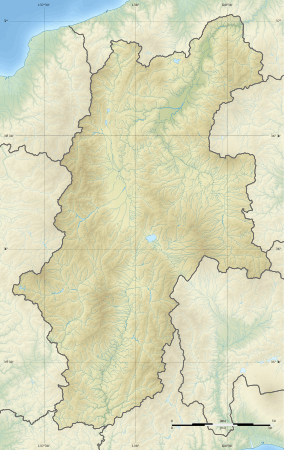Togariishi Museum of Jōmon Archaeology
The Togariishi Museum of Jōmon Archaeology (茅野市尖石縄文考古館, Chino-shi Togariishi Jōmon Kōkokan) is a municipal museum located in the city of Chino, Nagano Prefecture, Japan, specializing in artifacts of the Jōmon period (between 14,000 and 1000 BCE).[1]
茅野市尖石縄文考古館 | |
Jōmon Venus (NT) | |
 Location within Nagano Prefecture  Togariishi Museum of Jōmon Archaeology (Japan) | |
| Established | July 2000 |
|---|---|
| Location | 4734-132 Toyohira, Chino, Nagano-ken, Japan |
| Coordinates | 36°00′49″N 138°14′01″E |
| Website | Official website |
Togariishi Museum of Jōmon Archaeology
The museum was opened in July 2000. Its collection includes over two thousand artifacts includes two Jōmon period dogū that have been designated National Treasures, the "Jōmon Venus" and the "Masked Goddess".[2][3]
The Togariishi stone age ruins
The Togariishi stone age ruins (尖石石器時代遺跡, Togariishi sekki jidai iseki) is an archaeological site containing the ruins of a large scale Jōmon period settlement located in what is now part of the city of Chino, Nagano. It was one of the first Jōmon period settlements found in Japan. The site was designated a National Historic Site of Japan in 1942 and a Special National Historic Site in 1952.[4] Despite the designation “Stone Age” in its name, the site has no connection with the Japanese Paleolithic period.
The site is located in the Toyohira neighborhood of Chino, at the foot of Mount Yatsugatake at an altitude of 1000 meters. Over 50 mid-Jōmon period ruins are located in the foot of the Yatsugatake mountain area near the center of Nagano prefecture because of abundant spring water. Although the ruins were known since the Meiji period, they were first excavated by the archaeologist Hidekazu Miyasaka in 1929. At that time, the foundation of 33 pit dwellings arranged in a U-shape around a central plaza were discovered, along with numerous artifacts, including earthenware, stoneware, jewelry and obsidian tools. This was the first confirmed example of a Jōmon period settlement found, and was thus the forerunner of the study of that period of Japanese history. Further postwar excavations have revealed that the site contains at least 220 residence sites, making it the largest settlement in the vicinity of Mount Yatsugatake. The area covered by the Special Historical Site designation was expanded in 1993.
See also
References
- 当館の出版物 [Museum Publications] (in Japanese). Chino City. Retrieved 4 December 2016.
- 土偶 [Dogū] (in Japanese). Agency for Cultural Affairs. Retrieved 4 December 2016.
- 土偶/長野県中ッ原遺跡出土 [Dogū (Excavated from the Nakappara Site] (in Japanese). Agency for Cultural Affairs. Retrieved 4 December 2016.
- "尖石石器時代遺跡" (in Japanese). Agency for Cultural Affairs.
External links
![]()
- Togariishi Museum of Jōmon Archaeology (in Japanese)
- Chino city official site (in Japanese)